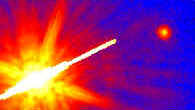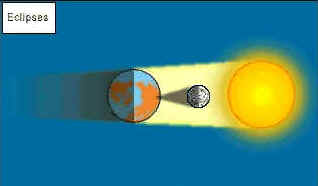Planet is any of the nine largest objects that travel around
the Sun. The Earth is a planet that travels around the Sun once a year. Going
outward from the Sun, the planets are  Mercury,
Venus, Earth, Mars, Jupiter, Saturn, Uranus, Neptune and Pluto. The Sun, the
planets and their satellites (moons), and smaller objects called
asteroids, meteors and comets make up the solar system
Mercury,
Venus, Earth, Mars, Jupiter, Saturn, Uranus, Neptune and Pluto. The Sun, the
planets and their satellites (moons), and smaller objects called
asteroids, meteors and comets make up the solar system
Black holes
Shooting stars
 Shooting
stars, or meteors, are the streaks of light you see at night. They are made by
pea-sized bits of rock or metal called meteoroids, which fall from space and
burn up in the Earths atmosphere.
Shooting
stars, or meteors, are the streaks of light you see at night. They are made by
pea-sized bits of rock or metal called meteoroids, which fall from space and
burn up in the Earths atmosphere.
People in Space
The first woman ever in space was Valentia Tereshova of the USSR (Now Russia).
She began training to be a cosmonaut in 1962, and on 16 June 1963 She was
launched into space in the spacecraft Vostok 6. She then spent more than two
days orbitting the Earth.
Soviet cosmonauts have lived for as long as a year on board space stations orbiting the Earth. Doctors study the effects of these long space flights on the cosmonauts bodies, to make sure they stay fit and well.
The Soviet cosmonaut Alexei Leonov made the first spacewalk, on 18 March 1965. Leonov left the Voshkod 2 spacecraft and stayed outside for 24 minutes. A safety rope was tied on so he did not float away.
The Sun
The Sun is exactly the same kind of heavenly object as the stars that you see at
night. This is hard to believe , because the Sun is so bright and hot and lights
up the hole sky , while the stars are faint-so faint that they can be seen only
when the sky is dark. The Sun is an ordinary star and the only real difference
between it and the other stars is that it is much nearer to the earth.It is that
makes it seem so much the brightest and hottest although there are many stars
that are bigger , brighter and hotter than the Sun.
The Suns light and heat make life possible on earth. The light and heat come from nuclear reactions which take place deep inside the Sun. Its light is so bright that it can hurt your eyes, and YOU SHOULD NEVER LOOK DIRECTLY AT THE SUN
Men have been interested in the Sun since ancient times
, when it was worshipped as a god. Modern astronomical study of the Sun began in
the 16th century, when Copernicus stated that the earth went round
the Sun. Until that time
people thought that the Sun went round the earth. Observatories all over the
world now make photographs of the sun on every clear day , and take moving
pictures of the behaviour of its surface. The outermost parts of the Sun ,
called the corona , are photographed during eclipses , when its bright surface
is hidden by the Moon or , at other times , with the special cameras called
coronagraphs.
Until that time
people thought that the Sun went round the earth. Observatories all over the
world now make photographs of the sun on every clear day , and take moving
pictures of the behaviour of its surface. The outermost parts of the Sun ,
called the corona , are photographed during eclipses , when its bright surface
is hidden by the Moon or , at other times , with the special cameras called
coronagraphs.
There are two types of Eclipses and they happen for different reasons. An eclipse of the Sun takes place if the if the Moon passes in front of the Sun. Sometimes the Moon blocks out the Sun completely and for a short time day becomes night. This is called a total eclipse there are also eclipses of the moon. These happen if the full Moon passes Through the Earths shadow.
Astronomers have found out more about the Sun than about other stars, because it is so much nearer to the earth.
